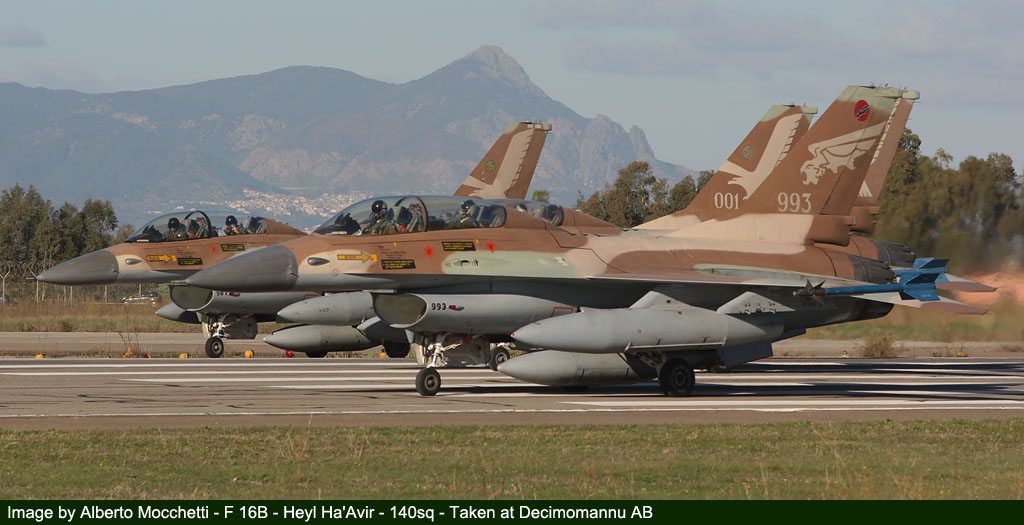 |
Si è conclusa Venerdì 26 Novembre l’esercitazione VEGA 2010 che si è svolta presso la base aerea di Decimomannu (Cagliari), che ha visto impegnati assetti aerei dell’Aeronautica Militare, della Israeli Air Force e della NATO.
L'Esercitazione Vega 2010 ha visto l'aeroporto militare di Decimomannu quale base logistica e di coordinamento delle attività addestrative; gli obiettivi delle attività sono stati il rafforzamento dell'interoperabilità dei reparti impegnati con il miglioramento della capacità di cooperazione e la standardizzazione e lo svolgimento di attività tattica simulando operazioni in aree di media scala in un ambiente ad alta minaccia.
La Vega 2010 si è svolta seguendo l'ormai collaudata formula adottata anche per le esercitazioni Trinex e Starex e che consente la massimizzazione dell'utilizzo delle capacità della struttura e dei mezzi presenti presso la base aerea di Decimomannu.
Massima attenzione anche all'impatto ambientale e a quello sul traffico aereo di linea generati dalle attività addestrative; le aree di esercitazione, per lo più sovrastanti il mare al largo delle coste della Sardegna centro-orientale, sono state rese il più possibile permeabili al traffico aereo civile, garantendo la piena sicurezza delle operazioni, al fine di ridurre ogni possibile ritardo e condizionamento sui collegamenti passeggeri da e per gli scali isolani. Inoltre durante le attività svolte non sono stati impiegati in alcun modo armamenti.
Nelle due settimane in Sardegna sono state impegnati per l’ esercitazione 38 velivoli di cui tre di supporto, 33 aerotattici e due elicotteri, per un totale di 600 ore di volo, gli equipaggi impiegati sono stati 100 e nel complesso il personale impiegato è stato di circa 600 militari.
La componente aerea italiana ha partecipato con caccia Eurofighter Typhoon, gli F 16ADF, i Tornado ECR, gli AMX ACOL, gli MB 339A, il tanker KC 130J e l'elicottero AB 212 impiegato per le missioni SAR (Search and Rescue). La componente aerea israeliana era composta da caccia F 15 “Baz” e F 16 “Netz” più una piattaforma di controllo e comando G550 “Eitam”. Mentre la NATO ha partecipato all'esercitazione con un velivolo E 3A AWACS.
Sono stati impiegati inoltre sistemi missilistici e di simulazione delle minacce terrestri di Capo San Lorenzo e Perdasdefogu per riprodurre le condizioni operative richieste dalle attività addestrative. |
 |
 |
|
L'autore desidera ringraziare il Col. Francesco Frare, il Ten.Col. Alfonsi e il Cap. Conti
Foto di Alberto Mocchetti
Testo di SMA Ufficio Pubblica Informazione
Novembre 2010
|
|
English translation by Dario Cocco
On Friday November 26th VEGA 2010 exercise draw to its conclusion. It was held at the Decimomannu (Cagliari) Airbase and saw the participation by aerial components of the Israeli Air Force and NATO.
The Vega 2010 Exercise saw the military airport of Decimomannu as the base for coordination of logistics and training activities; the objectives of the activities have been the strengthening of the interoperability of the departments involved with the improvement of the capacity for cooperation and standardization and implementation simulating the tactical activities in areas of medium-scale operations in a high threat.
The Vega 2010 was held following the now-proven formula used for the exercises and Trinex and Starex which allows the maximization of the use of the structure and the resources present at the Airbase of Decimomannu.
Maximum attention has been given to the environmental impact and to the effects on commercial air traffic generated by training activities. Exercise areas, mostly above the sea off the coast of central-eastern Sardinia, were made as permeable as possible to the civil air traffic, ensuring full safety of operations, in order to reduce any possible delays and disruptions to passengers travelling to and from the airport of the island. Also, during the activities, no weapons were used in any way.
During the two weeks in Sardinia have been committed to the Exercise a total of 38 aircraft including 3 on the support role, 33 fighter-bombers and 2 helicopters, amassing a total of 600 flight hours. The crews employed counted 100 and overall the number of personnel was about 600 soldiers.
The Italian air component has participated with Eurofighter Typhoons, F 16ADF, Tornado ECR, AMX ACOL, MB 339A, KC 130J tankers and a single AB 212 helicopter used for CSAR missions. The Israeli air component comprised F 15 "Baz" and F 16 "Netz" fighters plus a G550 “Eitam” used as a platform for command and control. NATO has participated to the exercise with an E 3B AWACS aircraft.
Missile and simulation of land-based threats systems were also used at Perdasdefogu and Cape San Lorenzo and to reproduce the operating conditions required by the training activities.
|
|
Special thanks to the Col. Francesco Frare, Lt.Col. Alfonsi and Capt. Conti
Images by Alberto Mocchetti
Text by SMA Public Information Office
November 2010
|
|